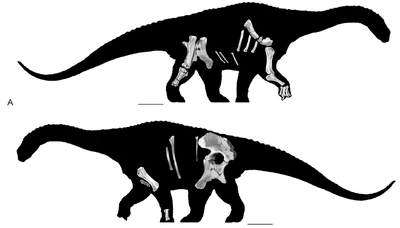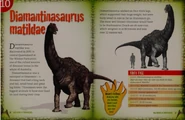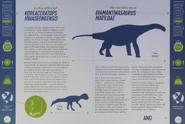| Diamantinasaurus matildae | ||||
|---|---|---|---|---|

| ||||
| Name | Diamantinasaurus matildae | |||
| Order | Saurischia | |||
| Suborder | Sauropoda | |||
| Class | Reptilia | |||
| Name Translation | Diamantina River Lizard | |||
| Period | Early Cretaceous | |||
| Location | Australia | |||
| Diet | Plants | |||
| Size | 52 feet (16 metres) | |||
Diamantinasaurus, meaning ("Diamtina River Lizard") is a genus of derived titanosaurian dinosaur from the Albian Stage of the Early Cretaceous age rocks of Australia. It is known from partial postcranial remains.
History of discovery[]
Diamantinasaurus was quite a big stocky dinosaur: it had a huge bulky, barrel-shaped body up to 52 feet (16 metres) long, thick, stout front and back limb bones which were just about the same length, and a box-shaped skull ant the end of its long neck similar to that of Camarasaurus. Diamantinasaurus is based on a partial skeleton including a right shoulder blade, a sternal plate, much of the forelimbs, much of the hindlimbs except the feet, partial hips, and ribs. Diamantinasaurus was unusual for a derived titanosaurian in retaining a thumb claw. Many titanosaurids are known to have had small armour plates, however, it is not known whether Diamantinasaurus had them.

Skeletal Restoration, A. Right Side, B. Left Side
Diamantinasaurus was described in 2009 by Scott Hucknoll and colleagues. The type species is D. matildae, in reference to the folk song "Waltzing Matilda", which was written by Banjo Paterson in nearby Winton where another Sauropod had been found called Wintonotitan. A phylogenetic analysis found Diamantinasaurus to be a lithostrotian titanosaurian sauropod, in the same clade as sauropods such as Opisthocoelicaudia and Saltasaurus. The discovery has been nicknamed "Matilda" after "Waltzing Matilda" and is probably the biggest Sauropod dinosaur in Australia.
Description[]
Classification[]
Paleobiology[]
The incomplete partial skeleton was found about 60 kilometres (37 miles) northwest of Winton, near Elderslie Station. It was recovered from the lower part of the Winton Formation, dated to the latest Albian. The incomplete partial skeleton was found in a clay layer between sandstone layers, interpreted as an oxbow lake deposit. Also found at the site were the type specimen of the theropod Australovenator, bivalves, fish, turtles, crocodilians, and plant fossils. The Winton Formation had a faunal assemblage including bivalves, gastropods, insects, the lungfish Metaceratodus, turtles, the crocodilian Isisfordia, pterosaurs, and several types of dinosaurs, such as the theropod Australovenator, the sauropod Wintonotitan, and unnamed ankylosaurians and hypsilophodonts. Diamantinasaurus bones can be distinguished from Wintonotitan bones because Diamantinasaurus bones are more robust. Plants known from the formation include ferns, ginkgoes, gymnosperms, and angiosperms. Like other sauropods, Diamantinasaurus would have been a large quadrupedal herbivore.




